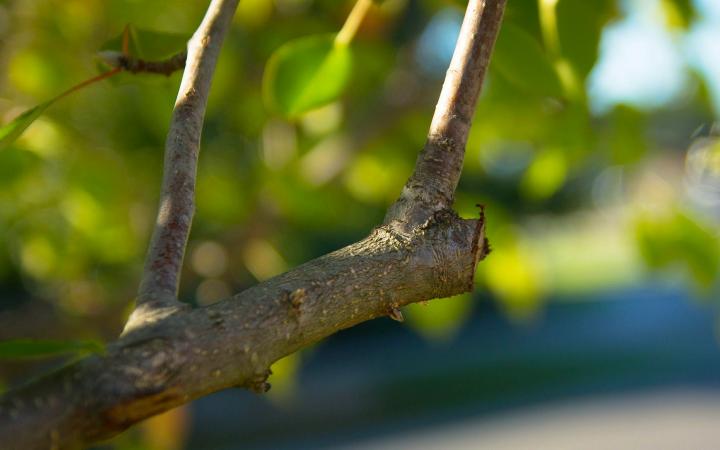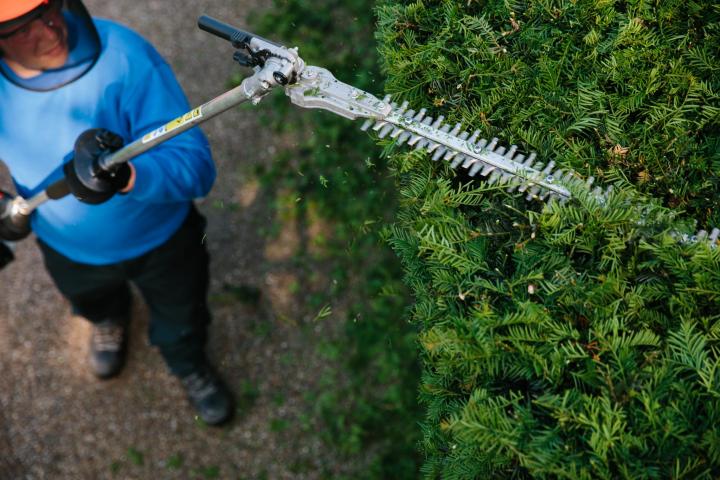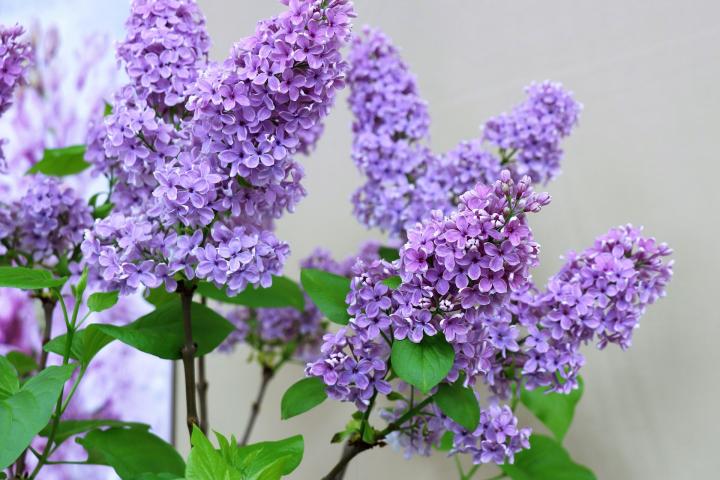Do you know how to prune correctly? Pruning directly benefits the health and visual appeal of shrubs and trees. Learn why to do it, how to do it, and when to do it.
WHAT IS PRUNING?
Pruning is the measured removal of parts (such as branches, stems, and flowers) from plants. It isn’t done just for shape and style, though. Pruning helps to manage the growth and structure of shrubs and trees, removes dead or diseased stems and branches, and encourages the development of flowers, fruit, and new foliage. Especially when to comes to woody plants like trees and shrubs, pruning is a great way to keep them growing in a healthy fashion.
The art of pruning is a skill that you can develop over time. Don’t be afraid to experiment and learn as you go, and don’t hesitate to consult a good book on the subject or check with your county extension office for information on pruning specific plants. By knowing your plant, its purpose, and especially when it blooms, you will be able to prune it correctly.
WHAT SHOULD BE PRUNED?
When pruning, the basic rule of thumb is that less is more. In other words, don’t prune recklessly; think about what you’re pruning BEFORE you make the cut. It’s easy enough to make another cut, but not so simple to reattach a branch!
The following are a few of the common things you should prune from trees and shrubs:
- Dead, Dying, Broken, or Diseased Branches:
- Any branches or stems that are dead, dying, diseased, or broken should be pruned. This can be done at any time of year—and the sooner, the better. At the very least, prune branches or stems before the plant produces new growth in spring so that it doesn’t waste energy on damaged areas. Removing dead or dying branches will not only help to prevent the spread of disease to other parts of the plant, but it will also help the tree or shrub to focus on producing new, healthy growth.
- Branches that Cross or Grow Inward or Downward:
- Remove branches that are growing across each other, or at least prune one of the offending limbs. Branches that touch can chafe and create an access point for insects and disease.
- Similarly, branches that grow inward toward the central stem or trunk are likely to end up chafing against other parts of the plant, so it’s best to prune them. It’s also important to allow some space for air to reach the center of the plant; if a tree or shrub becomes too grown in on itself, it is at greater risk of rot and other fungal diseases that thrive on humid, stagnant air.
- Branches that grow at a downward angle can pose a problem if they eventually make contact with the ground or nearby plants, which could expose them to disease and pests. In general, these branches are less productive and healthy; removing them helps to encourage healthier growth higher up in the plant. Low-growing branches can also be a hazard to humans or infrastructure, so safety is another reason to keep them in check.
- Suckers and Water Sprouts:
- Suckers (long shoots that grow out of the base of a tree or from its roots) should be pruned as close to the source as possible. Like the name entails, suckers are an energy drain on trees.
- Water sprouts (shoots growing straight up from the main branches of shrubs and trees) can be pruned as soon as you see them. Removing water sprouts helps to guide the shape and growth pattern of a tree or shrub. It also prevents branches from overlapping and chafing.
What and how much you should prune also depends on the age and size of the plant.
- Young Trees and Shrubs:
- Young woody plants should be pruned in a way that encourages them to produce a balanced, open structure of stems or branches. Watch out for crossed or inward-growing stems or branches especially—it’s better to “nip them in the bud” while they’re still easy to reach and cut!
- Remove crossing or rubbing branches, along with ones that are growing at an angle of thirty degrees or less relative to the trunk, as they are weakly joined and more likely to break off in storms.
- Remove branches that are growing closer to the ground than you would like once they reach about an inch in diameter. Leaving these branches in place when they are smaller than an inch in diameter will result in better root development and a sturdier trunk. Cut back branches to their point origin at the trunk or a lower branch; don’t leave stubs.
- Small twigs can be cut back to a bud to encourage more branching.
- Old Trees and Shrubs:
- Older trees and shrubs will often benefit greatly from pruning, as it will encourage them to produce new, vigorous growth that results in similarly healthy flowers and fruit.
- Shrubs with multiple stems, like viburnum, lilac, and forsythia, can take a harder pruning. Remove up to a third of old stems to encourage new growth.

HOW TO PRUNE TREES AND SHRUBS
Pruning Shrubs
When pruning shrubs, try to maintain the natural shape of the plants by removing individual branches. Using loppers or hand pruners, remove dead, damaged, crossing, and crowded branches back to the base of the plant. Avoid shearing flowering shrubs with hedge shears.
- Cut back to a bud that faces out, away from the central stem or trunk. New growth will emerge from this bud, so you want it to grow outward, not inward.
- Leave about ½ inch between the bud and where you make your cut.
- Cut at an angle that slants down and away from the bud in order to discourage water from collecting on the wound and running towards the bud.
- When pruning larger branches, cut back to a lateral branch—i.e., where a smaller branch emerges from the branch you are pruning.
Pruning Trees
Most deciduous and evergreen trees need little pruning once they’re established in your yard. There will be times, however, when you’ll need to do corrective pruning to remove a broken branch, diseased limb, or dead growth.
Prune side branches back to the main branch or trunk, leaving the collar (stub of a branch that resembles a raised ring around the base of the branch). Leaving this collar intact is essential to the proper healing of the wound.
When pruning large limbs, over 1-½ inches in diameter, use a pruning saw or bow saw to make a 3-part cut:
- The first cut should be made underneath the branch, about 6 to 12 inches away from the trunk. Only cut about ⅓ of the way through.
- Make the second cut 3 inches away from the first cut towards the end of the branch. As you are making the cut, the branch will fall.
- Finally, cut the remaining stub back to the branch collar.
For smaller branches, use a pruning saw or hand pruners to remove branches, cutting back to an outward-facing bud or intersecting branches.
Don’t cover pruning cuts with tree paint. Research has shown that sealing cuts and wounds on trees doesn’t speed healing and can, in fact, promote decay.
Pruning Hedges
Evergreen and deciduous hedges need periodic pruning throughout the growing season, starting in spring.
- For informal hedges of lilacs or other deciduous shrubs, use loppers or hand pruners to remove broken or dead branches, keeping the shape of the shrub intact.
- For evergreens in a formal setting, shear to keep the hedge shape and size in bounds.
Generally, be sure to leave the bottom of the hedge wider than the top so that sunlight can reach the bottom branches to promote lush growth.
Pruning Rose Bushes
Roses need yearly pruning to maintain their vigor and promote flowering. Hybrid roses are best pruned in spring to clean up old, unproductive growth. With hand pruners or loppers, remove all but 3 to 5 of the thickest and healthiest canes, and cut those back to a vigorous, outward-facing bud.
For shrub roses, cut spindly canes back by half their length or to 2 to 3 feet long. Cut or break off canes completely that grow from below the graft union (the bulge on the rose trunk near the ground where the varietal rose is attached to the rootstock rose). Remove diseased canes, and those that rub or crowd, back to healthy, outward-facing buds. If you see brown tissue in the center of a cane when you cut it, prune a little further back until the tissue is clear and healthy.
Read more about pruning roses.
CHOOSING THE RIGHT PRUNING TOOLS
Hand pruners, loppers, shears, trimmers—there are a number of different types of pruning tools out there and each has its purpose, but the options can get a little overwhelming. Here’s how to pick the right tool for the job:
- Hand Pruners — Next to the trowel, hand pruners are a gardener’s best friend. They’re small and light enough to be carried in a single hand or a pocket, but sharp enough to easily tackle any (small) stem that stands in their way. Use hand pruners to make precision cuts on small, soft stems and branches.
- There are two main types of pruners: anvil and bypass. Bypass pruners have overlapping blades, like scissors, while anvil pruners have a single blade that presses against a flat edge. Anvil pruners are prone to partially crushing the stem rather than cutting cleanly through it, which can expose the plant to disease and pests. For this reason, bypass pruners are recommended.
- Loppers — Once you’re dealing with branches greater than about ¼ inch in diameter, hand pruners may no longer make the cut. Rather than risk crushing or making an uneven cut, upgrade to loppers. Loppers are essentially larger, heavy-duty pruners with long handles that allow for greater leverage and thus, more power. They’re perfect for cutting thicker branches, stems, or roots that are too tough for hand pruners, while still getting a clean, precise cut.
- Pruning Saws — Contrary to popular belief, a saw is not always an extreme measure. Pruning saws, with their curved blades and sharp teeth, are specially designed to make clean cuts through branches that hand pruners and loppers can’t handle. They’re great for when you need to cut out large parts of a shrub or remove thicker branches from a tree. Plus, they also come in the form of the pole saw—essentially a saw on a stick—for when you need to reach higher branches and don’t want to risk using a ladder
- Hedge Shears — Traditional hedge shears, which look similar to giant scissors, are best suited to shaping evergreen hedges and topiary. Because their large blades make broad cuts, they should not be used for pruning most other shrubs and trees.
- Hedge Trimmers — Like shears, motorized hedge trimmers are used to shape broad areas of evergreen hedges and shrubs. They use sharp, reciprocating blades to make clean cuts more quickly, efficiently, and over larger areas than traditional shears. If the hedge you’re trying to trim is too large to tackle with traditional shears, we recommend using an extendable hedge trimmer.

While it’s tempting to spring for the cheapest pruning tools, in the end it will save you time and energy if you use equipment made from high-quality materials. Sharp blades make cleaner cuts, which prevents unnecessary damage to your trees and shrubs and makes pruning a whole lot easier for you.
Keep Pruning Tools Clean
Once you have the right tools for the job, it’s important to keep them clean—not only to extend the life of the tools, but to protect trees and shrubs from disease. Before and after pruning, sterilize your pruning equipment with rubbing alcohol to kill any disease-causing microbes that may have come into contact with the tools during use.
WHEN TO PRUNE
You can remove dead, dying, or broken branches as soon as you notice them, but when it comes to pruning for shape or size, we recommended following these guidelines:
- Early Spring: Prune summer-flowering trees and shrubs that bloom on the current season’s growth (new wood). This includes panicle hydrangea, rose-of-Sharon, summersweet (Clethra spp.), bush honeysuckle (Diervilla spp.), and Japanese spirea. Pruning in early spring allows these shrubs to focus their growth on the newly cut areas and prevents you from removing any stems that might have produced flowers.
- Early Spring: Prune evergreen shrubs or hedges in the spring before new growth emerges. Plants that are used in formal hedges and foundation plantings such as yew and privet can be trimmed with hedge shears to shape and to spur new growth. Arborvitae (Thuja spp.), juniper (Juniperus spp.), and boxwood (Buxus spp.) are other examples. Trim evergreen shrubs like junipers from the bottom up. Shorten branches that are expanding beyond the desired length by cutting them back to a lower branch beneath an overhanging branch. This provides a cleaner look, with the cuts hidden by the branches above.
- Early spring: Prune pines and spruce if needed to control size. Prune pines by snapping off the ends of the new growth ″candles″ before the needles begin to expand. Trim one-third to one-half of the candles to form a fairly dense tree. If you need to severely restrict the current year’s growth, some of the candles can be completely removed at their base. For denser growth, prune spruce by cutting back the long tip of new growth just above the point where the side shoots are forming.
- Early spring: For most fruit-bearing trees and shrubs, the earlier the better. Pruning can be done any time temperatures are above twenty degrees and before spring growth starts. Prune fruit trees to open up the interior, which will allow more light to reach into the crown and promote better fruit production. Pruning methods vary by kind of fruit tree grown. There are even some differences for particular cultivars within a species. Check with your local nursery, garden center, or extension agent for detailed instructions.
- Spring: Clean up roses by cutting out all wood that died over the winter. Cut canes back to healthy, live wood just above an outward-facing bud. Then prune to shape the bush and achieve the desired height.
- After Spring: Wait to prune spring-flowering shrubs that bloom on last season’s growth (old wood) until AFTER they are done flowering. If you wait to prune until too long after blooming, you will be removing stems that would have produced flowers next spring. Woody plants that bloom on old wood include rhododendrons (Rhododendron spp.), dogwoods (Cornus spp.), lilacs (Syringa spp.), forsythia (Forsythia spp.), and some hydrangeas (Hydrangea macrophylla, H. quercifolia).
NOW YOU’RE READY TO PRUNE!
Now you should have the knowledge AND the tools to keep the trees and shrubs in your garden healthy and looking great.
Source / The Old Farmer’s Almanac

